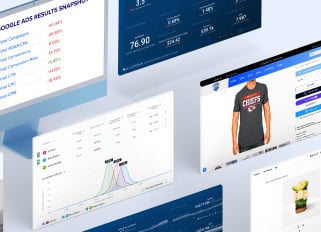
How to Track Facebook Ad Performance as an eCommerce Seller
Are you an eCommerce seller struggling to get the most out of your online advertising, including your Facebook ads? If so, it’s time to start tracking and measuring their performance.
Knowing how well your Facebook Ads campaign is doing will help you determine what needs improvement and where you should focus your efforts. In this blog post from BlueTuskr, we’ll discuss the key metrics and analytics that can give you greater insight into how effective your Facebook Ads truly are for your online store.
How Do Facebook Ads Work?
Facebook Ads are an ideal way for eCommerce sellers like you to reach a large audience of potential customers quickly and cost-effectively. These ads are delivered to users based on their unique interests, demographics, and behaviors.
Facebook Ad examples include sponsored stories, Facebook page post ads, and mobile app install ads. They can also include custom campaigns that you control and tailor to your specific target audiences, such as a Facebook video ad that plays when a user visits your page or an audience retargeting campaign that entices users who have already interacted with your brand.
Facebook Ads are designed to be simple and easy to understand so that you can create and run ads without the need for any technical knowledge. All you need is an active Facebook account, a budget, and some creative ideas.
Facebook Ads can be optimized to target specific audiences with precision, allowing you to focus your ad budget on capturing eyeballs most likely to convert into buyers.
Analytics
One of the major advantages of using Facebook Ads is that they offer comprehensive analytics and performance metrics. These allow you to track the performance of your brand awareness campaign in real-time, making adjustments as needed to maximize your ROI.
If you understand how to use this data rightly, you can monitor the amount of money spent, impressions received, click-through rates, conversions, cost per conversion, return on ad spend (ROAS), and more.
Targeting Options
You can also use advanced targeting options such as Custom Audiences or Lookalike Audiences to reach highly specific target audiences that are most likely interested in what you have to offer.
By leveraging the power of Facebook Ads and similar social media ads, online stores are now able to reach larger audiences faster and measure their success more precisely than ever before.
Through setting specific goals, optimizing targeting options, monitoring KPIs over time, and utilizing powerful analytics tools offered by platforms such as Facebook Business Manager, any business has the potential to maximize its advertising budget while seeing profitable results from its campaigns.

Understanding the Most Important Facebook Ads Metrics and Key Analytics
When taking advantage of what Facebook Ads have to offer for your business, it's important to track and measure how well they are doing. This means looking at key metrics such as customer acquisition cost (CAC), customer lifetime value (CLV), average order value (AOV), revenue per visitor (RPV), click-through rate (CTR), and conversion rate (CR).
- Customer Acquisition Cost (CAC) is how much it costs to get a customer.
- Customer Lifetime Value (CLV) is the amount of money earned from a customer over their entire time as a buyer.
- Average Order Value (AOV) is the average amount spent on each order.
- Revenue Per Visitor (RPV) is how much money one spends visiting your store.
- Click-through Rate (CTR) measures how often people click on your ads.
- Conversion Rate (CR) measures how many people actually buy something after clicking an ad or visiting your website after that ad appears in their feed.
Tracking all of these numbers, as well as factors such as post engagement rate, over time can help you figure out what needs improvement and where you should focus your efforts.
You can also use targeting options, including Facebook Custom Audiences or Lookalike Audiences, in order to reach people likelier to click through on your ads. Custom Audiences allow you to target Facebook users based on their browsing behaviors, while Lookalike Audiences take it a step further by finding more people like those who are already interested in what your store has to offer.

Know What You Need to Track
To get the most out of your Facebook Ad campaign, you'll need to identify which key performance indicators (KPIs) are most important for your business. When it comes to tracking these KPIs, CAC is especially important because it helps you understand exactly how much each new customer costs you.
It’s a good idea to compare this metric with your CLV, which measures the total amount of money earned from a customer over their entire time as a customer. This will give you an indication of whether you’re making enough from your customers to justify the investment you've made in acquiring them.
AOV is another important KPI that measures the average amount spent on each order – this can help you determine if customers are willing to spend more money or if there are certain products or promotions that encourage higher spending.
You can use the information obtained from your RPV metric to figure out what types of promotions are most effective at driving sales or if certain products generate more revenue than others. CTR is another metric that’s useful for gauging the success of your ads – measuring how often people click on your ads will give you insight into whether or not potential customers are engaging with them.
Lastly, conversion rate is probably the most vital stat because it lets you know how well your Facebook Ads are actually turning visitors into genuine customers. This is a metric that you should watch like a hawk.
Knowing which important Facebook Ads metric matters most for e-commerce success and keeping an eye on those analytics will help any online store stay on top of the pack.
Go-to Tracking Tools and Reports to Monitor
Facebook Ads Manager
Many eCommerce businesses use the Facebook Ads Manager to create, monitor, and measure their ads. This feature of your Facebook Ads account has a dashboard with key performance metrics included, such as impressions, clicks, conversions, cost per click (CPC), and return on ad spend (ROAS). With this information, you can analyze your company's campaigns and make adjustments accordingly.
Businesses should keep an eye on other important metrics such as click-through rate (CTR), which measures the percentage of people who actually clicked on an ad after seeing it. This is a great way to determine how effective an ad campaign is at engaging potential customers.
Facebook Insights
Facebook Insights is another helpful tool that can be used for tracking performance. It provides detailed insights into how many people are clicking on your ads or visiting your store. You can also use this report to analyze which audiences are responding best to your ads, allowing you to better optimize targeting options.
Google Analytics
Google Analytics is another great tool that allows you to track website visitors and measure how well eCommerce campaigns are performing. This platform provides detailed analytics reports that show the number of visits, conversions, and revenue generated from each campaign. While this doesn't directly measure Facebook Ad performance, it still provides valuable insights into the overall effectiveness of your eCommerce social media marketing.
Results-Based Tips for Optimizing Your Ads
In case all of this seems a bit overwhelming, here are some specific steps you can follow to start tracking your online store's Facebook ads like a pro.
1. Pinpoint the Right Audience
Having a well-defined target audience is essential to ensuring that your ads deliver positive results. Start by defining who your ideal customer is based on age, gender, location, interests, etc.
Once you have a good idea of what your ideal buyer looks like, use Facebook's powerful targeting tools to reach them. You should also take advantage of retargeting strategies such as lookalike audiences to generate even more qualified leads.
2. Set Up Your Facebook Ad Metrics and Analytics
To get the most out of your Facebook Ads, you need to access your dashboard, which will help you track key performance indicators such as click-through rate (CTR), cost per click (CPC), impressions, and conversion rate.
As you track these methods through Facebook Ad Manager, you can use the data to refine and adjust your ads, ensuring that they are always delivering the best possible results.
3. Monitor Your eCommerce KPIs
When it comes to evaluating your Facebook Ads, remember not to focus solely on clicks or views. You also need to pay attention to how effective your adverts are when it comes to actually converting customers. After all, this is what really matters when it comes to improving your return on investment.
4. Analyze Competitors' Performance
It never hurts to get inspired by what your competition is doing and use their success as a benchmark as you optimize your own content. Keeping an eye on the competition, even when it comes to something like Facebook Ads, can be incredibly beneficial for gaining insights into how you might adapt or improve upon their strategies.
5. Analyze Results Regularly
Finally, don't just set up your Facebook Ads and forget about them. Monitor their performance on a regular basis (weekly at a minimum) so you can make sure they are always driving the best results for your online store.
Final Takeaways
With the right strategies and tools, anyone can maximize their Facebook Ads to boost their eCommerce store’s potential. Whether it's tracking a Facebook metric or analyzing competitor performance, these tips will help you get started optimizing your top social media ads for better results.
With a bit of effort and dedication, you'll be able to create powerful Facebook Ads that drive more sales for your online store! So don’t wait, get started today and start seeing the positive results that effective social media marketing can bring to your bottom line. Interested in e-commerce Facebook ads services? Contact our team at Bluetuskr, an e-commerce marketing agency.
Connect With Us
Recent Post

.png)







Tell us what you think!